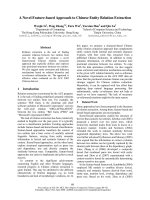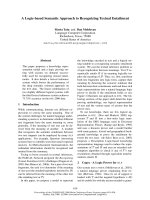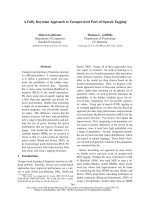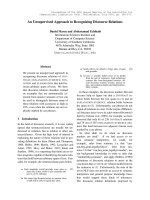Báo cáo khoa học: " A novel approach to inhibit HIV-1 infection and enhance lysis of HIV by a targeted activator of complement" doc
Bạn đang xem bản rút gọn của tài liệu. Xem và tải ngay bản đầy đủ của tài liệu tại đây (189.54 KB, 4 trang )
BioMed Central
Page 1 of 4
(page number not for citation purposes)
Virology Journal
Open Access
Hypothesis
A novel approach to inhibit HIV-1 infection and enhance lysis of HIV
by a targeted activator of complement
Yuanyong Xu
†1
, Chuanfu Zhang
†1
, Leili Jia
†1
, Cuirong Wen
2
, Huihui Liu
3
,
Yong Wang
1
, Yansong Sun
1
, Liuyu Huang
1
, Yusen Zhou*
4
and
Hongbin Song*
1
Address:
1
Institute of Disease Control and Prevention, Academy of Military Medical Science, Beijing 100071, PR China,
2
302 Hospital of People's
Liberation Army, Beijing 100039, PR China,
3
Chinese Center for Disease Control and Prevention, Department of Epidemiology, Beijing 100050,
PR China and
4
State Key Laboratory of Pathogen and Biosecurity, Beijing Institute of Microbiology and Epidemiology, Beijing 100071, PR China
Email: Yuanyong Xu - ; Chuanfu Zhang - ; Leili Jia - ;
Cuirong Wen - ; Huihui Liu - ; Yong Wang - ;
Yansong Sun - ; Liuyu Huang - ; Yusen Zhou* - ;
Hongbin Song* -
* Corresponding authors †Equal contributors
Abstract
Background: The complement system is one of the most potent weapons of innate immunity. It is not
only a mechanism for direct protection against invading pathogens but it also interacts with the adaptive
immunity to optimize the pathogen-specific humoral and cellular defense cascades in the body.
Complement-mediated lysis of HIV is inefficient but the presence of HIV particles results in complement
activation by the generation of many C3-fragments, such as C3dg and C3d. It has been demonstrated that
activation of complement can enhance HIV infection through the binding of special complement receptor
type 2 expression on the surface of mature B cells and follicular dendritic cells.
Presentation of the hypothesis: Previous studies have proven that the complement-mediated
antibody-dependent enhancement of HIV infection is mediated by the association of complement receptor
type 2 bound to the C3 fragment and deposited on the surface of HIV virions. Thus, we hypothesize that
a new activator of complement, consisting of a target domain (C3-binding region of complement receptor
type 2) linked to a complement-activating human IgG1 Fc domain (CR2-Fc), can target and amplify
complement deposition on HIV virions and enhance the efficiency of HIV lysis.
Testing the hypothesis: Our hypothesis was tested using cell-free HIV-1 virions cultivated in vitro and
assessment of virus opsonization was performed by incubating appropriate dilutions of virus with medium
containing normal human serum and purified CR2-Fc proteins. As a control group, viruses were incubated
with normal human serum under the same conditions. Virus neutralization assays were used to estimate
the degree of CR2-Fc-enhanced lysis of HIV compared to untreated virus.
Implications of the hypothesis: The targeted complement activator, CR2-Fc, can be used as a novel
approach to HIV therapy by abrogating the complement-enhanced HIV infection of cells.
Published: 12 August 2009
Virology Journal 2009, 6:123 doi:10.1186/1743-422X-6-123
Received: 1 June 2009
Accepted: 12 August 2009
This article is available from: />© 2009 Xu et al; licensee BioMed Central Ltd.
This is an Open Access article distributed under the terms of the Creative Commons Attribution License ( />),
which permits unrestricted use, distribution, and reproduction in any medium, provided the original work is properly cited.
Virology Journal 2009, 6:123 />Page 2 of 4
(page number not for citation purposes)
Background
The human immunodeficiency virus (HIV) causes severe
immune deficiency in humans and currently affects up to
42 million people worldwide. To date, there are no effec-
tive vaccines against HIV infection due to a number of
issues. Firstly, there have been several recent failures of
potential vaccine candidates in clinical trials. In 2003, two
phase 3 trials using gp120 protein for vaccination that
were aimed to raise sterilizing, antibody-mediated immu-
nity, failed to protect vaccinees from HIV infection [1,2].
Another vaccine trial using a different strategy (V520 of
Merck) was stopped prematurely in September 2007 due
to evidence that vaccinees may have been more suscepti-
ble to HIV infection than placebo control individuals [3].
Secondly, no effective therapeutic approach for "curing"
HIV infected individuals is currently under clinical inves-
tigation. Current therapies for HIV infection using highly
active antiretroviral therapy (HAART) are not able to elim-
inate virus completely and complications of these thera-
pies include severe side effects and viral resistance that
may establish latent reservoirs of HIV.
The complement system is a key component of innate
immunity and provides a first line of defense against
invading pathogens that can bridge the innate and adap-
tive arms of the immune system [4,5]. It is not only a
mechanism for direct protection against invading patho-
gens but also interacts with the adaptive immune system
to optimize the pathogen-specific humoral and cellular
defense cascade in the body, especially for viral patho-
gens. HIV, however, has evolved several mechanisms to
evade complement-mediated lysis (CML) and exploit the
complement system to increase viral infectivity [6]. Thus,
in light of recent failures for vaccine design, the present
study proposes an innovative approach to find a novel tar-
geted activator of complement for the elimination of HIV.
Presentation of the hypothesis
Interaction of HIV with the complement system
HIV infection leads to the immediate activation of the
complement system, even in the absence of HIV-specific
antibodies. However, after seroconversion, the presence
of HIV-specific antibodies triggers further activation of the
classical complement pathway [7]. Antibodies that may
enhance HIV infection in vitro were described shortly after
HIV had first been isolated. Robinson et al. [8] found that
sera from HIV-infected individuals enhance in vitro HIV
infection of the complement receptor type 2 (CR2;
CD21)-bearing T lymphoblastoid cell line, MT2. The
same authors demonstrated that this enhancement was
dependent on antibodies and mediated by complement
and coined the term complement-mediated antibody-
dependent enhancement (C-ADE) [9]. The mechanism of
C-ADE has been investigated by several studies during the
past two decades. As summarized by Robinson et al. [8],
binding of antibody to gp41 initiates the complement cas-
cade and leads to the deposition of the C3dg complement
component on the virion. Opsonized viruses subse-
quently bind to CR2 distributed on mature B cells and fol-
licular dendritic cells (FDC). Ultimately, the engagement
of CR2 and CD4 receptors by opsonized virions leads to
an increased rate of HIV spread through the tissue culture
with a ten-fold increase in viral reverse transcriptase
released into the culture medium and an increase in HIV
genomic RNA [10]. In addition, evidence from in vitro and
in vivo studies indicated that C-ADE occurs early in infec-
tion during the acute, high viremia phase [11,12].
Since complement activation is an extremely potent
mechanism of the innate immune system and is poten-
tially dangerous for host cells, it is tightly regulated. This
regulation is mediated by proteins such as cell surface-like
membrane cofactor protein (MCP), decay accelerating
factor (DAF) and protectin (CD59), and the soluble factor
H(fH) that can down-regulate complement activation at
several stages of cascade and protect host cells from com-
plement-mediated damage. The complement system is
strongly activated upon infection by HIV but CML of
viruses is inefficient [7,13]. The susceptibility of HIV to
CML has been shown to be dependent on the expression
of the MCP and CD59 complement-regulatory proteins
on infected cells [14]. Since HIV acquires the host cell
membrane and its associated membrane proteins (includ-
ing MCP, DAF and CD59) during budding, there is an
intrinsic resistance of the virus to CML [15,16]. Studies
have shown that blocking DAF and CD59 on HIV with
specific antibodies results in an increased sensitivity of
both primary isolates and laboratory-strains of HIV to
CML [17,18].
HIV infection results in the activation of the complement
system, even in the absence of HIV-specific Abs [19] and
results in the deposition of C3 fragments on the viral sur-
face both in vitro [20] and in vivo [21]. HIV bound extra-
cellularly to FDC in the germinal centers of lymph nodes
represent the largest viral reservoir in HIV-infected indi-
viduals [22,23]. The binding of this infectious pool of HIV
in the germinal centers depends mainly on interactions of
CR2 expressed on FDC (or B cells) with C3d fragments
attached to the viral surface [21,24]. In addition, an asso-
ciation of complement-opsonized HIV with peripheral B
cells through CR2-C3d interactions has been described in
HIV-infected individuals [25]. These CR2-C3d interac-
tions between B cells and HIV are critical for efficient B
cell-mediated transmission of complement-opsonized
HIV to T cells [26].
Complement receptor type 2 on target and bystander cells
Complement activation by the presence of HIV particles
results in the generation of many C3-fragments that are
Virology Journal 2009, 6:123 />Page 3 of 4
(page number not for citation purposes)
recognized by different complement receptors expressed
on various cell types [5]. Among these, C3dg and C3d
serve as ligands for CR2 with high affinity [19]. Binding of
C3d-coated particles induces a temperature-dependent
aggregation of CR2 in lipid rafts on cells. The cross-linking
of CR2 and the B-cell receptors through complement-
opsonized antigens decreases the threshold necessary for
B-cell activation and contributes to a prolongation of B-
cell antigen receptor signaling. Thus, CR2 plays an impor-
tant role in B-cell activation and combines the innate and
adaptive arms of the immune system. The CR2 on FDC
can bind opsonized immune-complexes (ICs) and is
important for B cell affinity maturation and the develop-
ment of B-cell memory. A major mechanism of FDC trap-
ping is binding of antibody and complement-opsonized
HIV to CR2 [24,27]. Viruses retained in this way, even in
the presence of neutralizing antibodies, have been shown
to remain infectious in vivo for months and comprise a
viral archive that can be transmitted to T cells and other
target cells migrating through germinal centers. Similarly,
infection of CD4+ T cells is facilitated by circulating B cells
that carry HIV bound to CR2. This mode of trans-infection
occurs with virus opsonized with complement alone or
with complement plus antibody [20,28].
The hypothesis
Recent findings have generated renewed interest in so-
called "non-neutralizing" antibodies that are unable to
directly inhibit free virus entry into target cells, but none-
theless, exhibit antiviral activity mediated by the Fc region
of the antibody molecule. These antibody effector mecha-
nisms include complement binding and viral lysis, phago-
cytosis of antibody-coated virions, and antibody-
dependent cellular cytotoxicity [29,30]. The complement
system constantly interacts with HIV during all stages of
infection highlighting the importance of CR2 in C-ADE.
Taken together, the hypothesis presented here investigates
a new strategy using a fusion protein to target and amplify
complement deposition on HIV virions regardless of
modulating complement inhibitor expression. The fusion
protein consists of target domain, the C3-binding region
of CR2, linked to a complement-activating human IgG1
Fc domain (CR2-Fc). The novel complement activator,
CR2-Fc, is expected to enhance complement deposition
and result in the further production of CR2 ligands
through the complement-activating Fc domain. Thus,
CR2-Fc will down-regulate complement inhibitors (MCP,
DAF and CD59) or block their function on HIV virions
that may enhance CML. More importantly, this targeted
complement activator is able to bind to sites of comple-
ment activation, so it is likely to improve their efficacy
while reducing potentially serious side effects resulting
from complement activation. Furthermore, the human
IgG1 Fc domain can also play a role of fixing complement
system, so the more complement activation that occurs
will lead to more CR2-Fc targeting to HIV. Subsequently,
the positive feedback loop generated by the complement
cascade results in enhanced lysis of HIV and preventing
infection of naïve cells.
Testing the hypothesis
After preparation of human CR2-Fc fusion protein, bio-
distribution studies were performed to evaluate the bio-
logic activity of CR2-Fc in vitro. HIV-1 was cultivated in H9
cells and cell-free virus obtained from supernatants. Infec-
tion experiments were performed in 24-well plates in trip-
licate and virus opsonization was performed by
incubating appropriate dilutions of HIV in culture
medium with normal human serum (NHS) and purified
CR2-Fc proteins. A control group included viruses that
were incubated with NHS only under the same condi-
tions. Finally, neutralization tests were used to estimate
the efficiency of CR2-Fc-enhanced lysis of HIV compared
to controls.
Implication of the hypothesis
A successful test of the hypothesis would demonstrate that
CR2-Fc can bind to HIV virions and can result in an ampli-
fication of the complement activation cascade. As a conse-
quence of this action, HIV would likely be eliminated by
CML and further infection by HIV should be inhibited.
Furthermore, CR2-Fc bound to HIV virions is likely to
reduce potential damage of host cells and tissues resulting
from excess complement activation. Thus, it is meaningful
to investigate the potential role of CR2-Fc for the abroga-
tion of HIV infection in humans, as this new finding
would suggest a novel approach for HIV therapy.
Competing interests
The authors declare that they have no competing interests.
Authors' contributions
YYX, CFZ, LLJ and HBS prepared the paper. CRW, HHL,
YW, YSS, LYH and YSZ participated in developing the
hypothesis and collaborated in writing and reviewing of
the article. All authors read and approved the final manu-
script.
Acknowledgements
This work was supported by the grants from the Chinese Ministry of Sci-
ence and Technology 863 project (No.2007AA02Z144) and 973 HIV
research Project(No.2006CB504201)
References
1. McCarthy M: AIDS vaccine fails in Thai trial. Lancet 2003,
362:1728.
2. McCarthy M: HIV vaccine fails in phase 3 trial. Lancet 2003,
361:755-756.
3. Cohen J: Promising AIDS vaccine's failure leaves field reeling.
Science 2007, 318:28-29.
4. Walport MJ: Complement. Second of two parts. N Engl J Med
2001, 344:1140-1144.
Publish with BioMed Central and every
scientist can read your work free of charge
"BioMed Central will be the most significant development for
disseminating the results of biomedical research in our lifetime."
Sir Paul Nurse, Cancer Research UK
Your research papers will be:
available free of charge to the entire biomedical community
peer reviewed and published immediately upon acceptance
cited in PubMed and archived on PubMed Central
yours — you keep the copyright
Submit your manuscript here:
/>BioMedcentral
Virology Journal 2009, 6:123 />Page 4 of 4
(page number not for citation purposes)
5. Stoiber H, Banki Z, Wilflingseder D, Dierich MP: Complement-HIV
interactions during all steps of viral pathogenesis. Vaccine
2008, 26:3046-3054.
6. Banki Z, Stoiber H, Dierich MP: HIV and human complement:
inefficient virolysis and effective adherence. Immunol Lett 2005,
97:209-214.
7. Stoiber H, Kacani L, Speth C, Wurzner R, Dierich MP: The support-
ive role of complement in HIV pathogenesis. Immunol Rev
2001, 180:168-176.
8. Robinson WE Jr, Montefiori DC, Mitchell WM: A human immun-
odeficiency virus type 1 (HIV-1) infection-enhancing factor in
seropositive sera. Biochem Biophys Res Commun 1987,
149:693-699.
9. Robinson WE Jr, Montefiori DC, Mitchell WM: Antibody-depend-
ent enhancement of human immunodeficiency virus type 1
infection. Lancet 1988, 1:790-794.
10. Robinson WE: Mechanism for complement-mediated, anti-
body-dependent enhancement of human immunodeficiency
virus type 1 infection in MT2 cells is enhanced entry through
CD4, CD21, and CXCR4 chemokine receptors. Viral Immunol
2006, 19:434-447.
11. Beck Z, Prohaszka Z, Fust G: Traitors of the immune system-
enhancing antibodies in HIV infection: their possible implica-
tion in HIV vaccine development. Vaccine 2008, 26:3078-3085.
12. Subbramanian RA, Xu J, Toma E, Morisset R, Cohen EA, Menezes J,
Ahmad A: Comparison of human immunodeficiency virus
(HIV)-specific infection-enhancing and -inhibiting antibodies
in AIDS patients. J Clin Microbiol 2002, 40:2141-2146.
13. Sullivan BL, Knopoff EJ, Saifuddin M, Takefman DM, Saarloos MN, Sha
BE, Spear GT: Susceptibility of HIV-1 plasma virus to comple-
ment-mediated lysis. Evidence for a role in clearance of virus
in vivo. J Immunol 1996, 157:1791-1798.
14. Saifuddin M, Ghassemi M, Patki C, Parker CJ, Spear GT: Host cell
components affect the sensitivity of HIV type 1 to comple-
ment-mediated virolysis. AIDS Res Hum Retroviruses 1994,
10:829-837.
15. Frank I, Stoiber H, Godar S, Stockinger H, Steindl F, Katinger HW,
Dierich MP: Acquisition of host cell-surface-derived molecules
by HIV-1. AIDS 1996, 10:1611-1620.
16. Saifuddin M, Hedayati T, Atkinson JP, Holguin MH, Parker CJ, Spear
GT: Human immunodeficiency virus type 1 incorporates
both glycosyl phosphatidylinositol-anchored CD55 and
CD59 and integral membrane CD46 at levels that protect
from complement-mediated destruction. J Gen Virol 1997,
78:1907-1911.
17. Saifuddin M, Parker CJ, Peeples ME, Gorny MK, Zolla-Pazner S, Ghas-
semi M, Rooney IA, Atkinson JP, Spear GT: Role of virion-associ-
ated glycosylphosphatidylinositol-linked proteins CD55 and
CD59 in complement resistance of cell line-derived and pri-
mary isolates of HIV-1. J Exp Med 1995, 182:501-509.
18. Stoiber H, Pinter C, Siccardi AG, Clivio A, Dierich MP: Efficient
destruction of human immunodeficiency virus in human
serum by inhibiting the protective action of complement fac-
tor H and decay accelerating factor (DAF, CD55). Exp Med
1996, 183:307-310.
19. Stoiber H, Pruenster M, Ammann CG, Dierich MP: Complement-
opsonized HIV: the free rider on its way to infection. Mol
Immunol 2005, 42:153-160.
20. Doepper S, Stoiber H, Kacani L, Sprinzl G, Steindl F, Prodinger WM,
Dierich MP: B cell-mediated infection of stimulated and
unstimulated autologous T lymphocytes with HIV-1: role of
complement. Immunobiology 2000, 202:293-305.
21. Banki Z, Kacani L, Rusert P, Pruenster M, Wilflingseder D, Falkensam-
mer B, Stellbrink HJ, van Lunzen J, Trkola A, Dierich MP, Stoiber H:
Complement dependent trapping of infectious HIV in
human lymphoid tissues. AIDS 2005, 19:481-486.
22. Burton GF, Keele BF, Estes JD, Thacker TC, Gartner S: Follicular
dendritic cell contributions to HIV pathogenesis. Semin Immu-
nol 2002, 14:275-284.
23. Smith BA, Gartner S, Liu Y, Perelson AS, Stilianakis NI, Keele BF,
Kerkering TM, Ferreira-Gonzalez A, Szakal AK, Tew JG, Burton GF:
Persistence of infectious HIV on follicular dendritic cells. J
Immunol 2001, 166:690-696.
24. Kacani L, Prodinger WM, Sprinzl GM, Schwendinger MG, Spruth M,
Stoiber H, Döpper S, Steinhuber S, Steindl F, Dierich MP: Detach-
ment of human immunodeficiency virus type 1 from germi-
nal centers by blocking complement receptor type 2.
J Virol
2000, 74:7997-8002.
25. Moir S, Malaspina A, Li Y, Chun TW, Lowe T, Adelsberger J, Baseler
M, Ehler LA, Liu S, Davey RT Jr, Mican JA, Fauci AS: B cells of HIV-
1-infected patients bind virions through CD21-complement
interactions and transmit infectious virus to activated T
cells. J Exp Med 2000, 192:637-646.
26. Dopper S, Wilflingseder D, Prodinger WM, Stiegler G, Speth C,
Dierich MP, Stoiber H: Mechanism(s) promoting HIV-1 infec-
tion of primary unstimulated T lymphocytes in autologous B
cell/T cell co-cultures. Eur J Immunol 2003, 33:2098-2107.
27. Ho J, Moir S, Kulik L, Malaspina A, Donoghue ET, Miller NJ, Wang W,
Chun TW, Fauci AS, Holers VM: Role for CD21 in the establish-
ment of an extracellular HIV reservoir in lymphoid tissues. J
Immunol 2007, 178:6968-6974.
28. Banki Z, Wilflingseder D, Ammann CG, Pruenster M, Mullauer B, Hol-
lander K, Meyer M, Sprinzl GM, van Lunzen J, Stellbrink HJ, Dierich
MP, Stoiber H: Factor I-mediated processing of complement
fragments on HIV immune complexes targets HIV to CR2-
expressing B cells and facilitates B cell-mediated transmis-
sion of opsonized HIV to T cells. J Immunol 2006,
177:3469-3476.
29. Hessell AJ, Hangartner L, Hunter M, Havenith CE, Beurskens FJ,
Bakker JM, Lanigan CM, Landucci G, Forthal DN, Parren PW, Marx
PA, Burton DR: Fc receptor but not complement binding is
important in antibody protection against HIV. Nature 2007,
449:101-104.
30. Willey S, Aasa-Chapman MM: Humoral immunity to HIV-1: neu-
tralisation and antibody effector functions. Trends Microbiol
2008, 16:596-604.









